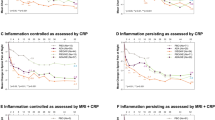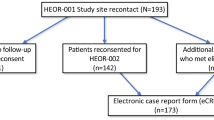Abstract
The objectives of the study are to demonstrate the non-inferiority of PG201 (Layla®) 600 mg in comparison with celecoxib 200 mg for the treatment of symptomatic knee osteoarthritis (OA). In total, 309 patients were randomly assigned to receive either the test drug, PG201 600 mg (n = 154) or celecoxib 200 mg (n = 155). The primary efficacy variable was improvement in mean 100-mm pain VAS score from baseline to the final visit (week 8), and this value was compared between the 2 treatment groups. Secondary outcome variables included changes from baseline in the Western Ontario and McMaster Universities Arthritis Index (WOMAC) pain VAS score and subscale score, patient’s global assessment of disease status quality of life (short form-36) and responder index at weeks 4 and 8. For safety assessment, adverse events were recorded at each clinical visit. At weeks 8, the 100-mm pain VAS scores were significantly decreased in patients receiving both PG201 600 mg (p < 0.0001) and celecoxib 200 mg (p < 0.0001) as compared to the baseline scores; however, no statistically significant differences in these values were noted between the groups (p = 0.312). These results met pre-specified criteria for non-inferiority for both the intent-to-treat and per-protocol populations. PG201 600 mg and celecoxib 200 mg were both well tolerated and no statistically significant differences in the tolerability profile between the groups. PG201 600 mg was as effective and safe as celecoxib 200 mg in the treatment of symptomatic knee OA and might be a useful new medication for the treatment of symptomatic knee OA.


Similar content being viewed by others
References
Poole AR (1999) An introduction to the pathophysiology of osteoarthritis. Front Biosci 4:D662–D670
Vuolteenaho K, Moilanen T, Knowles RG, Moilanen E (2007) The role of nitric oxide in osteoarthritis. Scand J Rheumatol 36:247–258
Martel-Pelletier J, Alaaeddine N, Pelletier JP (1999) Cytokines and their role in the pathophysiology of osteoarthritis. Front Biosci 4:D694–D703
Goldring MB, Birkhead JR, Suen LF, Yamin R, Mizuno S, Glowacki J, Arbiser JL, Apperley JF (1994) Interleukin-1 beta-modulated gene expression in immortalized human chondrocytes. J Clin Invest 94:2307–2316
Zhang W, Moskowitz RW, Nuki G, Abramson S, Altman RD, Arden N, Bierma-Zeinstra S, Brandt KD, Croft P, Doherty M, Dougados M, Hochberg M, Hunter DJ, Kwoh K, Lohmander LS, Tugwell P (2008) OARSI recommendations for the management of hip and knee osteoarthritis, Part II: OARSI evidence-based, expert consensus guidelines. Osteoarthr Cartil 16:137–162
Jordan KM, Arden NK, Doherty M, Bannwarth B, Bijlsma JW, Dieppe P, Gunther K, Hauselmann H, Herrero-Beaumont G, Kaklamanis P, Lohmander S, Leeb B, Lequesne M, Mazieres B, Martin-Mola E, Pavelka K, Pendleton A, Punzi L, Serni U, Swoboda B, Verbruggen G, Zimmerman-Gorska I, Dougados M; Standing Committee for International Clinical Studies Including Therapeutic Trials ESCISIT (2003) EULAR Recommendations 2003: an evidence based approach to the management of knee osteoarthritis: report of a task force of the standing committee for international clinical studies including therapeutic trials (ESCISIT). Ann Rheum Dis 3(62):1145–1155
Zhang W, Doherty M, Arden N, Bannwarth B, Bijlsma J, Gunther KP, Hauselmann HJ, Herrero-Beaumont G, Jordan K, Kaklamanis P, Leeb B, Lequesne M, Lohmander S, Mazieres B, Martin-Mola E, Pavelka K, Pendleton A, Punzi L, Swoboda B, Varatojo R, Verbruggen G, Zimmermann-Gorska I, Dougados M, EULAR Standing Committee for International Clinical Studies Including Therapeutics (ESCISIT) (2005) EULAR evidence based recommendations for the management of hip osteoarthritis: report of a task force of the EULAR standing committee for international clinical studies including therapeutics (ESCISIT). Ann Rheum Dis 5(64):669–681
American College of Rheumatology Subcommittee on Osteoarthritis G (2000) Recommendations for the medical management of osteoarthritis of the hip and knee: 2000 update. Arthritis Rheum 43:1905–1915
Gregory PJ, Sperry M, Wilson AF (2008) Dietary supplements for osteoarthritis. Am Fam Physician 77:177–184
Shin SS, Jin M, Jung HJ, Kim B, Jeon H, Choi JJ, Kim JM, Cho BW, Chung SH, Lee YW, Song YW, Kim S (2003) Suppressive effects of PG201, an ethanol extract from herbs, on collagen-induced arthritis in mice. Rheumatology (Oxford) 42:665–672
Park KC, Park EJ, Kim ER, Kim Y, Chung SH, Cho BW, Kim S, Jin M (2005) Therapeutic effects of PG201, an ethanol extract from herbs, through cartilage protection on collagenase-induced arthritis in rabbits. Biochem Biophys Res Commun 331:1469–1477
Altman R, Asch E, Bloch D, Bole G, Borenstein D, Brandt K, Christy W, Cooke TD, Greenwald R, Hochberg M (1986) Development of criteria for the classification and reporting of osteoarthritis: classification of osteoarthritis of the knee. Arthritis Rheum 29:1039–1049
Steinbrocker O, Traeger CH, Batterman RC (1949) Therapeutic criteria in rheumatoid arthritis. JAMA 140:659–662
Strand V, Kelman A (2004) Outcome measures in osteoarthritis: randomized controlled trials. Curr Rheumatol Rep 6:20–30
Ehrich EW, Davies GM, Watson DJ, Bolognese JA, Seidenberg BC, Bellamy N (2000) Minimal perceptible clinical improvement with the Western Ontario and McMaster Universities osteoarthritis index questionnaire and global assessments in patients with osteoarthritis. J Rheumatol 27:2635–2641
Angst F, Aeschlimann A, Michel BA, Stucki G (2002) Minimal clinically important rehabilitation effects in patients with osteoarthritis of the lower extremities. J Rheumatol 29:131–138
Bijlsma JW (2005) Patient centred outcomes in osteoarthritis. Ann Rheum Dis 64:1–2
Lachin JM (1981) Introduction to sample size determination and power analysis for clinical trials. Control Clin Trials 2:93–113
Sheldon E, Beaulieu A, Paster Z, Dutta D, Yu S, Sloan VS (2005) Efficacy and tolerability of lumiracoxib in the treatment of osteoarthritis of the knee: a 13-week, randomized, double-blind comparison with celecoxib and placebo. Clin Ther 27:64–77
Pham T, van der Heijde D, Altman RD, Anderson JJ, Bellamy N, Hochberg M, Simon L, Strand V, Woodworth T, Dougados M (2004) OMERACT-OARSI initiative: Osteoarthritis Research Society International set of responder criteria for osteoarthritis clinical trials revisited. Osteoarthr Cartil 12:389–399
Krasnokutsky S, Attur M, Palmer G, Samuels J, Abramson SB (2008) Current concepts in the pathogenesis of osteoarthritis. Osteoarthr Cartil 16(Suppl 3):S1–S3
Krasnokutsky S, Samuels J, Abramson SB (2007) Osteoarthritis in 2007. Bull Hosp Jt Dis 65:222–228
Pelletier JP, Pelletier JM, Abramson SB (2001) Osteoarthritis, an inflammatory disease: potential implication for the selection of new therapeutic targets. Arthritis Rheum 44:1237–1247
McKenna F, Borenstein D, Wendt H, Wallemark C, Lefkowith JB, Geis GS (2001) Celecoxib versus diclofenac in the management of osteoarthritis of the knee. Scand J Rheumatol 30:11–18
Goldstein JL, Correa P, Zhao WW, Burr AM, Hubbard RC, Verburg KM, Geis GS (2001) Reduced incidence of gastroduodenal ulcers with celecoxib, a novel cyclooxygenase-2 inhibitor, compared to naproxen in patients with arthritis. Am J Gastroenterol 96:1019–1027
Scheiman JM, Cryer B, Kimmey MB et al (2004) A randomized, controlled comparison of ibuprofen at the maximal over-the-counter dose compared with prescription-dose celecoxib on upper gastrointestinal mucosal injury. Clin Gastroenterol Hepatol 2:290–295
Clegg DO, Reda DJ, Harris CL, Klein MA, O’Dell JR, Hooper MM, Bradley JD, Bingham CO 3rd, Weisman MH, Jackson CG, Lane NE, Cush JJ, Moreland LW, Schumacher HR Jr, Oddis CV, Wolfe F, Molitor JA, Yocum DE, Schnitzer TJ, Furst DE, Sawitzke AD, Shi H, Brandt KD, Moskowitz RW, Williams HJ (2006) Glucosamine, chondroitin sulfate, and the two in combination for painful knee osteoarthritis. N Engl J Med 354:795–808
Sawitzke AD, Shi H, Finco MF, Dunlop DD, Harris CL, Singer NG, Bradley JD, Silver D, Jackson CG, Lane NE, Oddis CV, Wolfe F, Lisse J, Furst DE, Bingham CO, Reda DJ, Moskowitz RW, Williams HJ, Clegg DO (2010) Clinical efficacy and safety of glucosamine, chondroitin sulphate, their combination, celecoxib or placebo taken to treat osteoarthritis of the knee: 2-year results from GAIT. Ann Rheum Dis 69:1459–1464
Dougados M, Moore A, Yu S, Gitton X (2007) Evaluation of the patient acceptable symptom state in a pooled analysis of two multicentre, randomised, double-blind, placebo-controlled studies evaluating lumiracoxib and celecoxib in patients with osteoarthritis. Arthritis Res Ther 9:R11
Tannenbaum H, Berenbaum F, Reginster JY, Zacher J, Robinson J, Poor G, Bliddal H, Uebelhart D, Adami S, Navarro F, Lee A, Moore A, Gimona A (2004) Lumiracoxib is effective in the treatment of osteoarthritis of the knee: a 13 week, randomised, double blind study versus placebo and celecoxib. Ann Rheum Dis 63:1419–1426
Conaghan PG, Dickson J, Bolten W, Cevc G, Rother M (2013) A multicentre, randomized, placebo- and active-controlled trial comparing the efficacy and safety of topical ketoprofen in Transfersome gel (IDEA-033) with ketoprofen-free vehicle (TDT 064) and oral celecoxib for knee pain associated with osteoarthritis. Rheumatology (Oxford) 2:1303–13012
Acknowledgments
This clinical study was supported in part by R&D Center of PMG Pharm Co., Ltd. The authors would like to thank Mi-Hyun Cho, Seok-Min Yoon of ADM Korea Inc. (CRO) and Hae-Kwan Eo, Young-Chin Chun of PMG Pharm Co., Ltd.
Conflict of interest
The authors declare that they have no conflicts of interest concerning this article.
Author information
Authors and Affiliations
Corresponding author
Rights and permissions
About this article
Cite this article
Yoo, WH., Yoo, HG., Park, SH. et al. Efficacy and safety of PG201 (Layla®) and celecoxib in the treatment of symptomatic knee osteoarthritis: a double-blinded, randomized, multi-center, active drug comparative, parallel-group, non-inferiority, phase III study. Rheumatol Int 34, 1369–1378 (2014). https://doi.org/10.1007/s00296-014-2964-8
Received:
Accepted:
Published:
Issue Date:
DOI: https://doi.org/10.1007/s00296-014-2964-8




